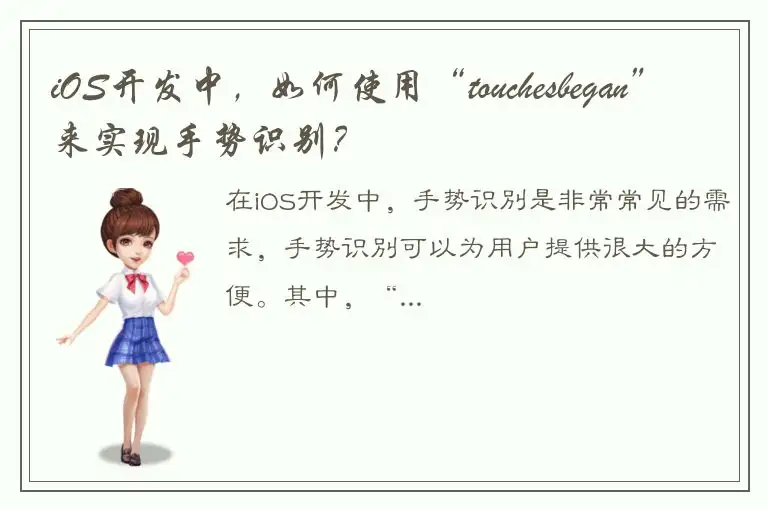在iOS开发中,手势识别是非常常见的需求,手势识别可以为用户提供很大的方便。其中,“touchesbegan”是iOS中实现手势识别的一个方法。
“touchesbegan”是UIResponder类的一个方法,它是触摸事件的起始点,在用户开始触摸屏幕时被调用。在这个方法中,我们可以获取用户触摸的位置信息,并进行一些自定义的处理。通过在这个方法中判断手势的类型,就可以实现手势识别。

接下来,我们将详细介绍如何在iOS开发中使用“touchesbegan”方法实现手势识别。
一、获取触摸点的位置信息
在“touchesbegan”方法中,我们可以通过UITouch类获取用户在屏幕上触摸的位置信息。UITouch类提供了一些有用的属性,例如locationInView:和previousLocationInView:。
其中,locationInView:方法返回的是当前触摸点在视图中的位置,以CGPoint类型表示,而previousLocationInView:方法返回的是上一个触摸点在视图中的位置。我们可以通过这两个方法获取用户手指触摸的位置信息。
下面是一个示例代码:
```
- (void)touchesBegan:(NSSet *)touches withEvent:(UIEvent *)event {
UITouch *touch = [touches anyObject];
CGPoint touchPoint = [touch locationInView:self.view];
NSLog(@"Touch point: (%f, %f)", touchPoint.x, touchPoint.y);
}
```
这段代码会在用户触摸屏幕时被调用,并打印出触摸点的位置信息。
二、判断手势的类型
通过获取用户的触摸点位置信息,我们可以判断用户的手势类型。常见的手势类型包括:点击、双击、长按、滑动、捏合等。
1. 点击手势
在“touchesbegan”方法中记录下用户按下的时间,然后在“touchesEnded”方法中计算按下时间和抬起时间之间的时间差,如果时间差小于一定值,则可以判断为点击手势。
下面是一个示例代码:
```
- (void)touchesBegan:(NSSet *)touches withEvent:(UIEvent *)event {
touchStartTime = [[NSDate date] timeIntervalSince1970];
}
- (void)touchesEnded:(NSSet *)touches withEvent:(UIEvent *)event {
double touchEndTime = [[NSDate date] timeIntervalSince1970];
double touchDuration = touchEndTime - touchStartTime;
if (touchDuration < 0.5) {
NSLog(@"Tap gesture detected.");
}
}
```
这段代码会在用户触摸屏幕时记录下按下时间,然后在用户抬起手指时计算时间差,如果时间差小于0.5秒,则判断为点击手势。
2. 滑动手势
在“touchesMoved”方法中,我们可以获取当前触摸点和前一个触摸点的位置信息,通过计算两个点之间的距离和方向,就可以判断出用户的滑动手势。
下面是一个示例代码:
```
- (void)touchesBegan:(NSSet *)touches withEvent:(UIEvent *)event {
UITouch *touch = [touches anyObject];
startPoint = [touch locationInView:self.view];
}
- (void)touchesMoved:(NSSet *)touches withEvent:(UIEvent *)event {
UITouch *touch = [touches anyObject];
CGPoint currentPoint = [touch locationInView:self.view];
CGFloat dx = currentPoint.x - startPoint.x;
CGFloat dy = currentPoint.y - startPoint.y;
if (fabs(dx) > fabs(dy)) {
// 水平滑动
if (dx > 0) {
NSLog(@"Swipe right gesture detected.");
} else {
NSLog(@"Swipe left gesture detected.");
}
} else {
// 垂直滑动
if (dy > 0) {
NSLog(@"Swipe down gesture detected.");
} else {
NSLog(@"Swipe up gesture detected.");
}
}
}
```
这段代码会在用户滑动屏幕时记录下滑动起始点的位置,在用户滑动过程中计算当前触摸点的位置并与起始点的位置进行比较,从而判断出用户的滑动方向。
3. 捏合手势
捏合手势是指用户用两个手指同时按住屏幕并进行移动,这时我们需要计算两个手指之间的距离和方向来判断用户的手势。
下面是一个示例代码:
```
- (void)touchesBegan:(NSSet *)touches withEvent:(UIEvent *)event {
if ([touches count] == 2) {
NSArray *allTouches = [touches allObjects];
startPoint1 = [[allTouches objectAtIndex:0] locationInView:self.view];
startPoint2 = [[allTouches objectAtIndex:1] locationInView:self.view];
}
}
- (void)touchesMoved:(NSSet *)touches withEvent:(UIEvent *)event {
if ([touches count] == 2) {
NSArray *allTouches = [touches allObjects];
CGPoint currentPoint1 = [[allTouches objectAtIndex:0] locationInView:self.view];
CGPoint currentPoint2 = [[allTouches objectAtIndex:1] locationInView:self.view];
CGFloat distance = sqrt(pow(currentPoint1.x - currentPoint2.x, 2) + pow(currentPoint1.y - currentPoint2.y, 2));
CGFloat previousDistance = sqrt(pow(startPoint1.x - startPoint2.x, 2) + pow(startPoint1.y - startPoint2.y, 2));
CGFloat scale = distance / previousDistance;
if (scale > 1) {
NSLog(@"Pinch open gesture detected.");
} else {
NSLog(@"Pinch close gesture detected.");
}
}
}
```
这段代码会在用户用两个手指按住屏幕时记录下两个手指的位置,在用户移动这两个手指时计算它们之间的距离并与初始距离进行比较,从而判断出用户的捏合手势。
三、结语
以上是使用“touchesbegan”方法来实现手势识别的一个示例,可以看出,“touchesbegan”方法的灵活性非常高,我们完全可以通过这个方法来实现自己需要的手势识别功能。当然,除了“touchesbegan”方法之外,iOS还提供了很多手势识别的API,如UITapGestureRecognizer、UIPanGestureRecognizer、UISwipeGestureRecognizer等等,根据不同的需求选择不同的API,可以更方便地实现手势识别功能。




 QQ客服专员
QQ客服专员 电话客服专员
电话客服专员